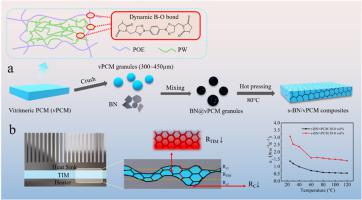Our official English website, www.x-mol.net, welcomes your feedback! (Note: you will need to create a separate account there.)
Vitrimeric phase change material facilitating 3D-structured boron nitride network for reliable thermal conductive interface materials
Polymer ( IF 4.6 ) Pub Date : 2024-03-28 , DOI: 10.1016/j.polymer.2024.126989 Rui-Ying Bao , Li-Mei Peng , Jie Yang , Lu Bai , Ming-Bo Yang , Wei Yang
Polymer ( IF 4.6 ) Pub Date : 2024-03-28 , DOI: 10.1016/j.polymer.2024.126989 Rui-Ying Bao , Li-Mei Peng , Jie Yang , Lu Bai , Ming-Bo Yang , Wei Yang

|
Phase change materials (PCMs) shows great promise as thermal interface materials (TIMs) due to their compliance and thermal management properties from solid-liquid phase transition characteristics. However, the significantly reduced thermal conductivity resulting from that randomly dispersed thermal conductive fillers susceptible to localized volume change by solid-liquid phase transition deteriorates the reliable heat transfer of TIM but is often overlooked. In this work, 3D-structured network of boron nitride (BN) fillers is created in vitrimeric PCM (vPCM) consisting of dynamic covalent crosslinked polyolefin elastomer (POE)/paraffin wax (PW) blends. The resulted composites with interconnected BN network show a through-plane thermal conductivity () of 3.08 W m K at 29.8 vol% BN. Significantly, the composites can keep the BN network continuous when heated, and remain of about 1.4 W m K after the solid-liquid phase transition of PW, which ensures reliable heat transfer when achieving thermal management by melting endotherm of PW. Moreover, the composites conform to the surface topography of sandwiching surfaces through solid plasticity under low stress when the crosslinked network rearranges via the exchange of dynamic covalent bonds activated by the melting of POE, reducing the thermal contact resistance. When the composites are used as TIM through thermally triggered reconfigurable package procedures at 80 C and 50 kPa, the heat dissipation is better than a commercial thermal pad with of 3.86 W m K. Vitrimeric PCM facilitates reliable 3D-structured BN network and thermally triggered conformability, paving a promising way for high-performance TIM with excellent heat dissipation.
中文翻译:

玻璃相变材料促进 3D 结构氮化硼网络的可靠导热界面材料
相变材料 (PCM) 由于其固液相变特性的顺应性和热管理特性,显示出作为热界面材料 (TIM) 的巨大前景。然而,随机分散的导热填料易受固-液相变引起的局部体积变化的影响,导致导热系数显着降低,从而降低了 TIM 的可靠传热性能,但常常被忽视。在这项工作中,在由动态共价交联聚烯烃弹性体 (POE)/石蜡 (PW) 共混物组成的玻璃化 PCM (vPCM) 中创建了氮化硼 (BN) 填料的 3D 结构网络。所得到的具有互连 BN 网络的复合材料在 29.8 vol% BN 的情况下表现出 3.08 W m K 的平面热导率 ()。值得注意的是,该复合材料在加热时可以保持BN网络连续,并且在PW固液相变后保持约1.4 W m K,这确保了通过熔化PW吸热实现热管理时可靠的传热。此外,当交联网络通过 POE 熔化激活的动态共价键交换而重新排列时,复合材料通过低应力下的固体塑性符合夹层表面的表面形貌,从而降低了接触热阻。当复合材料在 80 C 和 50 kPa 下通过热触发可重构封装程序用作 TIM 时,散热效果优于 3.86 W m K 的商用导热垫。Vitrimeric PCM 有助于实现可靠的 3D 结构 BN 网络和热触发一致性,为具有优异散热性能的高性能TIM铺平了道路。
更新日期:2024-03-28
中文翻译:

玻璃相变材料促进 3D 结构氮化硼网络的可靠导热界面材料
相变材料 (PCM) 由于其固液相变特性的顺应性和热管理特性,显示出作为热界面材料 (TIM) 的巨大前景。然而,随机分散的导热填料易受固-液相变引起的局部体积变化的影响,导致导热系数显着降低,从而降低了 TIM 的可靠传热性能,但常常被忽视。在这项工作中,在由动态共价交联聚烯烃弹性体 (POE)/石蜡 (PW) 共混物组成的玻璃化 PCM (vPCM) 中创建了氮化硼 (BN) 填料的 3D 结构网络。所得到的具有互连 BN 网络的复合材料在 29.8 vol% BN 的情况下表现出 3.08 W m K 的平面热导率 ()。值得注意的是,该复合材料在加热时可以保持BN网络连续,并且在PW固液相变后保持约1.4 W m K,这确保了通过熔化PW吸热实现热管理时可靠的传热。此外,当交联网络通过 POE 熔化激活的动态共价键交换而重新排列时,复合材料通过低应力下的固体塑性符合夹层表面的表面形貌,从而降低了接触热阻。当复合材料在 80 C 和 50 kPa 下通过热触发可重构封装程序用作 TIM 时,散热效果优于 3.86 W m K 的商用导热垫。Vitrimeric PCM 有助于实现可靠的 3D 结构 BN 网络和热触发一致性,为具有优异散热性能的高性能TIM铺平了道路。



























 京公网安备 11010802027423号
京公网安备 11010802027423号